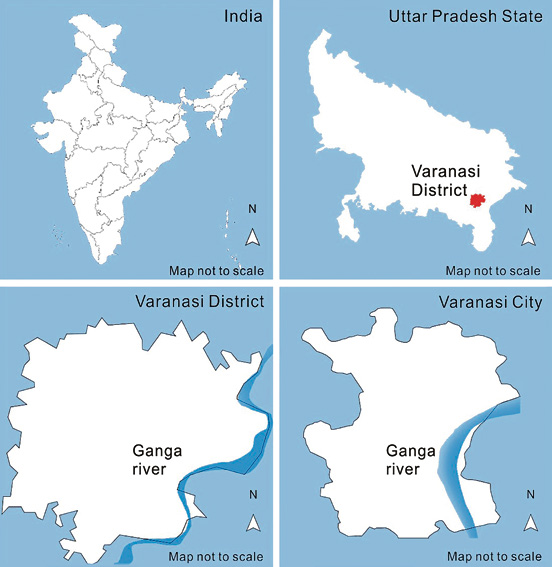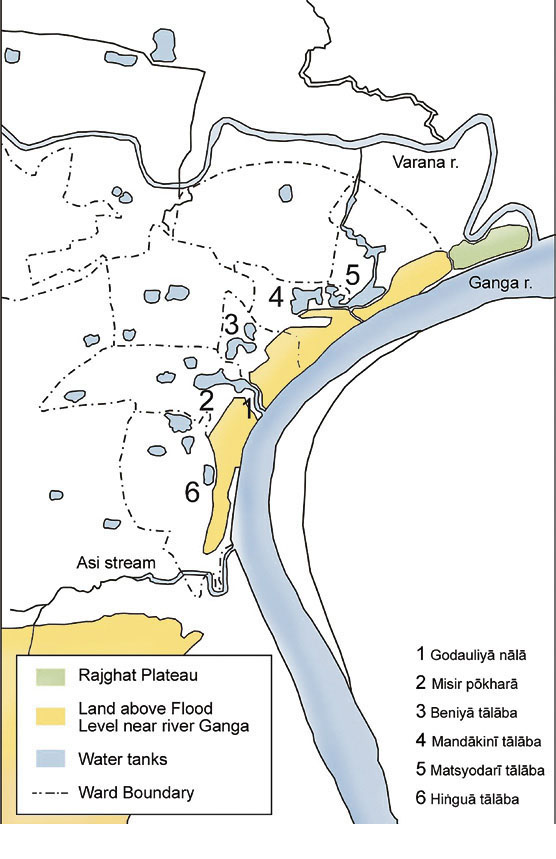Spatial Texts of Purāṇa-s and Sacred Temple Tanks of Varanasi
For many centuries, the hydrological landscape of Varanasi was characterised by the river Ganga and its tributaries, numerous temple tanks, ponds, and catchment areas. The spatial texts of the Purāṇa-s provide a valuable source for understanding the sacred and fluid landscape of Varanasi before colonial powers invaded. The term ‘spatial text’ is created to establish a concealed understanding of the spatial dynamics of Varanasi composed in the texts of Purāṇa-s. This empirical exercise will further strengthen the premise of the continuity of temple tanks and temples that formed the sacred geography of this ancient city. The descriptive texts in the Purāṇa-s provide an additional source for reconstructing the precolonial geography of Varanasi.
Varanasi is probably one of the few ancient sacred cities on the Indian subcontinent that has been continuously visited, devotedly explored, meticulously mapped, intensely written about, and documented for more than two thousand years. In scriptures and various works of literature, the city is also referred to as Ānandakānana (forest of bliss), Avimukta (the place never forsaken by Śiva), Rudravāsa (the dwelling place of Śiva), Mahāśmaśāna (the great cremation ground), Kāśī (city of light/shine), Varanasi (sacred geography between the Varana and Asi rivers), and Banaras. 1 Situated amidst the vast and fertile plains of the river Ganga, the city has an exceptional location [Fig. 2]. The city lies on the west side of the Ganga on a natural limestone embankment with an average height of 77 metres. The alluvial deposits carried by the Ganga on its western course eventually formed a prominent natural embankment at a high level. With its celestial features, rich legendary tales, and significant geological features, the river Ganga has successfully dominated the entire floodplain and has significantly influenced many ancient and sacred cities, including Varanasi, which flourished on its banks. The waters of the Ganga not only nourish the civilisation that has developed on its vast floodplains, but the geomorphological features of the high natural embankments have created several inland ponds and streams.

Fig. 2: The geographic location of Varanasi city, India. Note: Map not to scale.
(Map made by the author)
In Varanasi, in addition to these inland water bodies, the river Varana and a smaller stream (nālā) called Asi have a confluence with the Ganga in the north and south, respectively. This natural setting reinforces the notion that water is ubiquitous in Varanasi. The water bodies of the city are denoted as sacred temple tanks. The term ‘sacred’ is used explicitly in the context of a sanctified place, a place of pilgrimage, or a place close to a sacred river or a sacred reservoir of water. Instead of words such as holy, divine, and religious, the term ‘sacred’ is used exclusively as an epithet to develop the unique relationship of certain places closely linked to the water reservoirs, supplemented by prehistoric events, as well as stories and tales that revere the sacred geography of the place.
Temple tanks
The temple tanks denote various forms of water reservoirs, such as kuṇḍa, pōkharā, puṣkariṇī, bāvalī, etc. The temple tanks are located near the temple or are part of the temple complex [Fig. 1]. As is the case elsewhere on the Indian subcontinent, almost all forms of water reservoir in Varanasi are closely associated with the pantheon of Hindu deities. One of the most famous wells is Jñāna Vāpī (Well of Wisdom), which lies to the north of the current Kashi Vishwanath temple complex. A variety of rituals, socio-cultural practices, fairs, and festivals are associated not only with the water reservoirs, but also with their catchment areas, which suitably encapsulate the worship of water as a purifying agent.
Twenty types of temples and their descriptions are listed in Bṛihatsaṁhitā , the most notable work by the renowned 6th-century Indian astronomer and polymath Varāhamihira. In the 56th chapter, it is mentioned that the site of the temple should be close to a water tank and a garden. The temple tank is typically of a square or rectangular design, with natural inlets and outlets. On all four sides, there are masonry steps leading down to the water, made of clay-baked bricks or sandstone with some ornamental features. These steps are integrated with the ramps and may or may not be bricked up to the sides of the water tanks. 2 Many of the temple tanks in Varanasi have a small well in the centre, which plays a role in the recharging of the groundwater.
In Varanasi, one can see a variety of architectural forms and patterns of the temple tanks. Lolārka kuṇḍa, on Asi ghāṭa (masonry steps leading to the river), near the banks of the river Ganga, is a unique example [Fig. 3]. This temple tank has a deep well surrounded by steep stairs leading down to the water. The circular well is surrounded by walls in the shape of a cylinder and is open at the top. There is also a small platform that is added to the series of steps. As you go down the stairs, you will see many small sculptures carved into the stones of the surrounding walls. Devotees and seekers flock to this ancient temple tank during the months of August and September to take a dip and perform the rituals. Many temple tanks also had akhāḍā-s (a gymnasium and wrestling arena) nearby. Regular members who practice in akhāḍā-s talk about the dynamic relationship akhāḍā has with an adjoining temple and temple tank. The active members, mostly older men, tell stories of bathing in the tanks or ponds of the neighbouring temples and equate it with taking a dip in the river Ganga. During my fieldwork, regular members often told me that it is the water of the river Ganga that flows into these various temple tanks and ponds, and therefore bathing in these water tanks is also sacred.
Fig. 3: Lolārka kuṇḍa. (Photo by the author, February 2017)
Spatial texts of Purāṇa-s
Purāṇa-s are part of the Smṛtiḥ texts and are considered an important branch of Hindu literature. One way of describing this vast literature is as an 'encyclopaedia' of stories from the ancient past. Purāṇa-s exist from the ancient period, and their main function is to explain and augment the Vedaḥ. The total number of Purāṇa-s is 18, and they contain lucid descriptions of mountains, rivers, and sacred pilgrimage sites throughout the Indian subcontinent, which are considered an essential source for the study of historical geography. 3 All 18 Purāṇa-s have a reference to Varanasi, stories narrating its origin and celestial features. Among all of these Purāṇa-s, geography covered and discussed in the Bhuvanakośa 4 section of Skanda Purāṇa arguably outranks the other texts. 5 The dates of composition of the Purāṇa-s have been variously claimed. The oldest manuscript of the Skanda Purāṇa was dated around the 6th century CE. In particular, the spatial texts shed light on the fluid landscape of Varanasi in ancient times and the pre-colonial period. The spatial text of these sections and pilgrimage digests about Varanasi describe an elevated land and a moderate slope, surrounded by streams and bodies of water with different take prototypes [Fig. 4].

Fig. 4: Drainage pattern and geographical features of Varanasi. (Image traced and edited by the author, based on a map in R. L. Singh, Banaras: A Study in Urban Geography [Nand Kishore, 1955])
Skanda Purāṇa comprises seven chapters (khaṇḍa), and among the seven chapters, chapter four split into two sections are titled Kāśī Khaṇḍa. Kāśī Khaṇḍa is part of the extensive ‘Sthāna Māhātmya’ literature and is a valuable source for the understanding of the various strata and composition of the ancient city of Varanasi. Sthāna means place, and Māhātmya is a body of literature that tells of the greatness and virtues of the deities and temples associated with that sacred natural place. The qualitative description of Varanasi in the chapters of Kāśī Khaṇḍa subtly interweaves the celestial and terrestrial features of the city, which is constantly shaped and transformed by its unique elevated location, surrounding rivers and streams, and inland temple tanks.
This natural phenomenon of high elevation appears in an allegorical way in the spatial text of Kāśī Khaṇḍa. Some of the verses describe Varanasi as a renowned place that is on the earth but not on the ground. 6 Varanasi is celestial and is placed on the tip of the trident of Śiva and did not inundate even during the deluge. These three tips of the trident are the three embankments, – commonly referred to as three divisions (khaṇḍa) – of the city, namely Omkāra khaṇḍa in the north, Viśveśvara khaṇḍa in the middle and Kedāra khaṇḍa in the south.[7]
The texts describe the spatial characteristics and the location of the temples that correspond to the temple tanks in the vicinity, and they construct a map for the reader to navigate and make a circumambulation around the specific temples. The Kāśī Khaṇḍa extensively lists the names of temples, the rituals to be performed, and the sacred bathing in the temple tanks. Such tanks are an integral architectural structure of the temple complex. The descriptions and locations of more than 281 temple tanks are given in the two sections of Kāśī Khaṇḍa. The spatial text describes the structural features, curative properties of the water, geographical location and settings, etymology, and the activities that are closely connected with the temple tanks. Particular temple tanks are often cited in the context of their supremacy, virtuous qualities, merits, and blessings associated with the ablution ritual. Despite constant natural and human intervention, all three of these sacred temple tanks are still active and surviving water structures.
Concluding remarks
The spatial texts recognise the centrality of the free-flowing water in its various forms and how it preserves the sanctity of the place. The spatial texts are revisited to comprehend the natural environs of the city. Varana and Asi – two streams joining the celestial river Ganga and numerous inland temple tanks – continuously play with the environs and coalesce to form the sacred landscape. The repository of numerous fluid water bodies and their description establishes the constant flow of water and how the superfluous water was swimmingly incorporated into the physical settings. Kāśī Khaṇḍa has numerous expressions; it continuously invokes the intrinsic the city’s relationship with water and reiterates that ‘water sensitivity’ is the fountainhead of the entire script. The descriptive text reveals the footprints of pre-colonial geography through its commentary, and this footprint is still visible in today’s urban and populous Varanasi.
Mahesh Madhav Gogate is an affiliated researcher at Kyoto University, Japan, studying the sacred and fluid geography of Varanasi, India. His research focuses on the transformation of water heritage sites and urban water management.
Email: mimawork@gmail.com